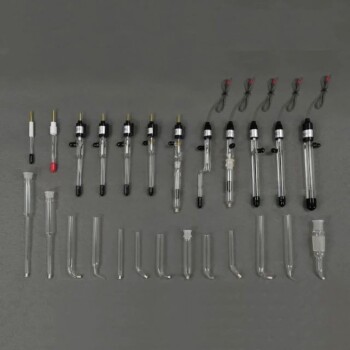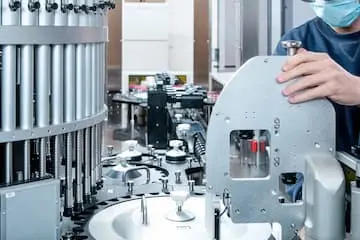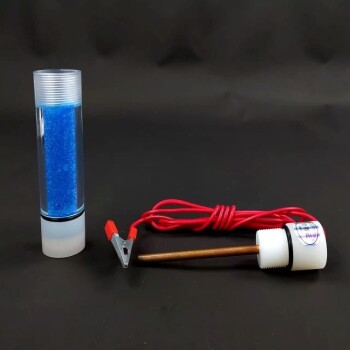A reference electrode is a stable electrode with a well-known electrode potential. It is used to complete the electrical circuit necessary for an electrochemical measurement. The reference electrode provides contact with the sample through its liquid junction and provides a stable and reproducible potential to which the indicating electrode potential can be compared. The typical reference electrode consists of an internal element, normally silver-silver chloride, surrounded by an electrolyte-containing filling solution, which is contained in either a glass or plastic body salt bridge, which terminates at the liquid junction.
Toggle Categories
Get Instant Support
Choose your preferred way to connect with our team
-
Get Free Quote Fill out form for detailed pricing
-
Send Email Detailed inquiry support
-
WhatsApp Quick mobile chat
Response Time
Within 8 hours on working days, 24 hours on holidays
reference electrode

Reference Electrode Calomel Silver Chloride Mercury Sulfate for Laboratory Use
Item Number : ELERA
$19.90
Our Ag/Ag+ pseudo-reference electrode is suitable for most organic solvents, while our commercially available reference electrodes are "no-leak" and suitable for many non-aqueous applications. Our platinum auxiliary electrode is inert and the most commonly used material, while other less expensive materials such as carbon and copper can also be used. Trust us to provide you with the most reliable and accurate reference electrode solutions.
Applications of Reference Electrode
- Used to measure the potential difference between the working electrode and the solution, making it possible to determine the redox potential of the analyte solution.
- Used as a standard for the calibration of other electrodes.
- Used in electrochemical experiments involving non-aqueous solutions to determine the redox potential of the solution.
- Used in potentiometric titrations to determine the endpoint of the titration.
- Used in various electroanalytical techniques such as cyclic voltammetry, chronoamperometry, and impedance spectroscopy to study electrochemical reactions.
- Used in the electroplating industry to measure the potential difference between the anode and the cathode in order to control the thickness and quality of the plating.
- Used in the corrosion industry to measure the potential difference between the metal surface and the solution in order to determine the corrosion rate and to evaluate the effectiveness of corrosion inhibitors.
- Used in the field of bioelectrochemistry to study the redox properties of biological molecules and their interactions with other molecules.
Advantages of Reference Electrode
- Provides a stable and reproducible potential for accurate measurements.
- Ensures analytical process efficiency with fast response time.
- Helps to maintain the electrical circuit necessary for an electrochemical measurement.
- Compatible with a wide range of samples.
- Can be used in conjunction with any half-cell.
- Allows for the determination of the cell potential in electrochemical cells.
- Used in various electrochemical measurements and devices such as DPV and electrochemical biosensors.
- Different types of reference electrodes are available to suit different applications.
- Double junction electrodes have lower chambers that can be customized to match the sample, ensuring compatibility.
- A range of common reference systems is available, such as Saturated Calomel (Hg/HgCl), Ag/AgCl, Cu/CuSO4, Hg/HgSO4, and Hg/HgO.
- Ag/AgCl is the most common reference system, while saturated calomel electrodes (Hg/HgCl) are very stable.
- The reference electrode plays an important role in electrode measurements, and a greater knowledge of its role is essential for accurate measurements.
Our Reference Electrode is a cost-effective solution that comes with a complete customisation service. It offers a wide range of advantages such as compatibility with different solvents, high accuracy, and stability. Our electrodes are available as a standard solution, or you can opt for a custom-designed electrode to cater to your specific requirements. Our electrodes are designed to provide a constant current density and potential, ensuring consistent results. Our electrodes are ideal for use in electrochemical cells, and we offer a no-leak guarantee.
FAQ
What Is Reference Electrode With An Example?
What Is The Role Of Reference Electrode?
What Is Reference Electrode Used For?
What Is A Reference Electrode Vs Counter Electrode?
What Is The Difference Between Standard And Reference Electrode?
REQUEST A QUOTE
Our professional team will reply to you within one business day. Please feel free to contact us!
Related Articles

Guide to Reference Electrodes in Electrochemical Measurements
Detailed guide on reference electrodes, their use, maintenance, checking methods, regeneration, storage, and applications.

Glymercury Electrode: Composition, Characteristics, and Applications
An in-depth look at the glymercury electrode, its composition, characteristics, and applications in analytical chemistry.

Use and Care of Reference Electrodes
Detailed guide on the use, calibration, and maintenance of reference electrodes in electrochemical studies.

Design and Application of Reference Electrodes in Lithium Batteries
An in-depth analysis of the design, features, and applications of reference electrodes in lithium batteries.

Understanding Electrodes in Electrochemical Systems: Working, Counter, and Reference Electrodes
An overview of the roles and characteristics of working, counter, and reference electrodes in electrochemical systems.

Design Principle and Application of Reference Electrodes for Lithium Batteries
Discusses the design principles, types, applications, and future directions of reference electrodes in lithium batteries.

Electrochemistry Basics: Conditions and Precautions for Using Different Reference Electrodes
A guide on the requirements and conditions for using various reference electrodes in electrochemistry.

Identifying and Addressing Issues with a Bad Reference Electrode in Measurement Systems
This article discusses the signs and solutions for a bad reference electrode in measurement systems, focusing on IR voltage drop, high-frequency artifacts, and methods to identify and save a bad reference electrode.

Design and Application of Reference Electrodes in Lithium Batteries
This article discusses the selection and design of reference electrodes for lithium batteries, focusing on active materials like lithium metal, lithium alloys, and lithium-embedded oxides.

Exploring Rotating Electrode Technology in Electrochemistry
An in-depth analysis of rotating electrode technology, its applications, and its impact on electrochemical reactions under different flow conditions.

Understanding the Rotating Disk Electrode: Principles and Applications
Explores the development, principles, and applications of the rotating disk electrode in electrochemistry.

Electrochemical Advancements and Applications
A comprehensive overview of the historical development, theoretical advancements, and practical applications of electrochemistry.

Steady State Measurements in Electrochemistry
An in-depth look at steady state measurements in electrochemistry, including techniques and applications.

Basic Principles and Applications of Rotating Disc Electrodes
Explores the development, principles, and applications of Rotating Disc Electrodes in electrochemistry.

Electrolytic Cell Design and Standards
A comprehensive guide on the design and criteria for electrolytic cells, crucial for accurate electrochemical testing.

Essential Equipment for Mass Production of Solid-State Batteries: Isostatic Press
Discusses the role of isostatic pressing technology in enhancing solid-state battery performance and production efficiency.

XPS Powder Sample Preparation and Precautions
Guidelines for preparing and handling powder samples for XPS analysis.

Comprehensive Guide to Reference Electrodes: Types, Applications, and Selection Criteria
Explore the world of reference electrodes with our detailed guide. Learn about different types, their applications, and how to select the right one for your needs. Ideal for researchers and lab technicians.

Understanding Saturated Calomel Reference Electrodes: Composition, Uses, and Considerations
Explore the detailed guide on saturated calomel reference electrodes, including their composition, advantages, disadvantages, and applications. Ideal for researchers and lab technicians.

Advanced Techniques in Coating Evaluation Using Electrolytic Cells
Explore the comprehensive guide on coating evaluation using electrolytic cells, covering electroplating, sol-gel methods, and wet chemical techniques. Enhance your understanding of metal coating properties and applications.

